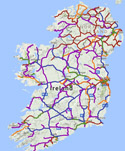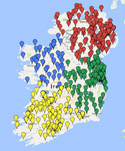Kneecap Pain
There are many types and causes of knee pain. Knee pain is thought to constitiute 41% of chronic cycling injuries. In the last article I looked at the ITB and pain on the outside of the knee, in this article I am going review non traumatic pain involving the kneecap (patella). You may have heard of the terms patallofemoral pain (PFP), chondromalacia patellae or runners knee – all used to describe pain around or under the kneecap.
This problem is not limited to cyclists; athletes active in sports such as running, skiing, football or other sports where a lot of pressure is put through their knees can suffer with it. It is common with up to 25% of sport participants complaining of this type of pain.
Symptoms
Common symptoms of patella femoral pain can include:
Pain located around or under the kneecap noticed when cycling, prolonged sitting, stair climbing, kneeling, hoping, running
Gradual onset, not related to any traumatic event such as a fall, twist, or knock
Stiffness after sitting for long periods
Crepitus or crunching noises under the knee cap
What causes the pain?
In order to understand how it occurs, it is useful to understand the structure of the knee and the kneecap. The kneecap is a triangular shaped bone that runs in a groove formed by the thigh bone (or femur). At the top the quadriceps tendon inserts into it, below the patellar tendon connects it to the shin bone (or tibia) and from each side fibrous tissue that surrounds the knee join attach to it, and from the right side it also receives attachments from the vastus medialis (VMO).
The kneecap moves in this groove when the knee bends and straightens. When the kneecap does not track properly in the groove, it can rub on the sides of the groove leading to pain and inflammation. In these cases the kneecap tracks too laterally i.e. it tends to track more to the outside of the knee. Due to the excessive lateral tracking, stress can also be placed on the fibrous tissue on the inside of the knee. This can also be a source of inflammation and pain.
Anything that changes the way the kneecap moves in the groove can lead to patellofemoral pain. This can include:
Muscle Imbalances
Imbalances between the muscles on the outside (lateral quads, ITB) of the leg versus the inside (VMO): the lateral muscles can put a stronger pull on the kneecap than the VMO can meet, leading to weakness and strain of the VMO. The VMO is particularly susceptible to weakening after knee injury where the leg is immobilised or full range of knee motion is restricted for a period of time. Sometimes clients will report a feeling of strain or tenderness just to the top inside of the knee which they can feel by pressing when the knee is bent. They notice it during cycling, running or stair climbing. This can be a sign that the VMO is weak, and if not addressed could later lead to pain around the kneecap.
Studies have shown that tight ITB, weak gluteus medius and abductors, weak external rotators, and weak core can give rise to instability in the pelvis. Pelvic instability can cause the thigh bone (femur) to rotate inward more than usual. This might be observed as a side to side movement of the knee when extending the leg during the downstroke, instead of the desired linear movement of the knee as you push down on the pedal. This changes the orientation of the groove so the kneecap does not track in it properly leading to pain. A rough test of your pelvic stability would be to perform a lunge or squat and note whether the knee rolls inwards as you perform it. Your knee should keep pointing straight and not dip or turn inwards. Or alternatively as mentioned in the article on ITB problems, excessive hip dipping while cycling would also be another indicator that the gluteus medius and abductor s are weak.
Anatomical Reasons
Increased foot pronation. Pronation is the rolling inwards of the foot during walking or running or cycling. Excessive pronation or over pronation can lead to problems at the knee. While this movement happens at the foot, it also causes a compensatory movement in the shin bone which affects the alignment at the knee impacting the kneecap and causing pain.
The position of the shin bone, excessive inward or outward rotation of the lower leg can affect the alignment at the knee. It has been suggested that people with low arches may be more susceptible to PFP than those with normal arches as low arches change the alignment of the shin bone. The positioning of your cleats can affect the position of the shin bone and the rotation of the lower leg.
Leg length discrepancies: when setting saddle height only one leg is correctly fitted to the pedal meaning that if the bike is fitted to suit the shorter leg, there will be increased compression of the kneecap in the groove and pain. Leg length discrepancies can occur due to rotations at the pelvis, or more unusually, if you were born with them.
Bike Set up & Training
When cycling, a saddle set to far forward will increase the wear and tear forces on the knee and the likelihood of knee pain. Similarly cycling with the saddle too low will have the same effect. As mentioned above your cleat positionng will also affect the rotation of the shin bone and possibly impact your knee.
Training: sudden increases in training, a lot of hill work, or cycling in high gears with low cadence can cause problems.
What can you do to help it?
The best thing to do is to get assessed and treated by your Physical Therapist. They will advise you on what needs to be strengthened, work out tight muscles, perform mobilisations to realign the pelvis and correct leg length if needed, tape your knee, and determine whether to refer you for orthotics should you need them. Also consider seeing a bike fit specialist to ensure your bike setup is optimal.
Just a note on taping: Tape can be applied to the kneecap to put it into the correct alignment and try and reduce pain when training or racing and is often used as part of the rehabilitation process. Kinesio tape (the bright blue, pink or black tape you might see people wearing) can also be used to help align the kneecap, as well as supporting the VMO, and reducing the tension through the tight muscles. But at the end of the day you need to fix the root cause – muscle imbalance, gait or feet, pelvic instability – to get longer term relief from knee pain.
Often prevention is better than cure so the following are worth considering:
Prevent imbalances around the knee:
Stretch lateral quads, hamstring, ITB (or use foam roller) and the calfs to keep all muscles around the hip and knees flexible
If you notice strain or pain on the inside of the knee strengthen the VMO. Also consider adding VMO strengthening exercises to your pre season strength and conditioning programme. See sample exercises below.
Prevent imbalances at the pelvis
Strengthen the gluteus medius. The gluteus medius is a key muscle in maintaining pelvic stability. See exercises below. A study was carried to research the effect of additional strengthening of hip abductor and lateral rotator muscles (gluteus medius) in a strengthening quadriceps exercise rehabilitation programme for patients with the patellofemoral pain syndrome. The first group focused on strengthening the quadriceps muscles only, the second group strengthened the quadriceps and the gluteus medius. After 6 weeks the second group were found to have a better improvement in symptoms that the first group.
Stretch or use a foam roller for the ITB
Stretch the hip flexors. Tight hip flexors can contribute to pelvic instability
Consider core work to improve overall pelvic stability.
Massage
Massage can be useful to help loosen out tight muscles such as quads, ITB, calfs and hamstrings
Use a foam roller self massage the ITB
Training
If you have a problem consider resting from cycling until you have strengthened up the relevant muscles. If you insist on training then try to avoid hills, and focus on low intensity training sessions until you have identified and resolved the root cause of your problem.
Bike.
If you are a time trailer or tri-athlete a forward seat height can give aerodynamic advantage but consider adjusting seat height back to relive the forces on the knee when training on long distance cycles.
Check your cleats and saddle position and ensure they are not contributing to the problem.
Exercises
I have included some sample exercises to help prevent or assist with knee pain. If you are suffering from knee pain a therapist will tailor a more specific rehabilitation programme for you based on your individual assessment and requirements.
Neuromuscular control of VMO
This exercise ensures that the VMO is contracting correctly. This ability to contract correctly and at the right time (called neuromuscular control) can be inhibited by pain or swelling in the knee. Sit on the ground with your leg outstretched in front of you. Put your hand just above the knee and a little to the inside – this is the VMO. Now try and bring the back of your knee to touch the floor, i.e. straighten the leg more. You should feel your VMO contract. If not repeat this exercise until you can feel the VMO start to contract, and continue it until the VMO is contracting for each repetition. Progress to trying this standing up when weight bearing on the leg so the exercise then becomes more functional.
VMO Alphabet
Once the VMO is contracting properly, this exercise will help to continue strengthen it.
Sit on the floor and support your body weight on your hands
Raise your leg approx 6 inches (15 cm) off the floor.
Keeping your leg straight, point you foot and using your foot as a “pen” draw the alphabet in the air.
The movements should be small and you should feel the VMO working as you do the exercise.
Strengthening the gluteus medius.
See the article on the ITB pain for pictures of the exercise.
Lie on your side with the side to be strengthened on top
Bend the lower leg slightly at the hip and knee for stability
Bring the leg backwards so it lies behind the hip.
Slowly raise the upper leg until 1-2 inches over the hip
From this position slowly lower the leg (1 repetition)
Repeat: 10-12 repetitions on each side, and build up to being able to perform 3 sets, three times a week
Note: place your hand on the gluteus medius – this is located above and to the outside of your jeans back pockets. You should feel the contraction here as you raise your leg upwards. It is important to keep the leg behind you as this localises the effort to the gluteus medius muscle, if it comes forward to much other muscles become involved. Also do not raise the leg much over the level of hip, raising it higher just involves use of the back muscles and it’s not working the gluteus medius. Add ankle weights if 3 sets can be done easily.
Lunges or squats
When you have built up the strength of the VMO and gluteus medius perform a lunge or squat exercise. With weak pelvic stablisers, the knee can roll inwards when performing a squat or lunge. The aim of this exercise is to develop knee control and to further strengthen the quads, abductors and gluteal muscles so that the knee does not roll inward. When performing the exercise the ensure knee stays in line with the toes and does not move inwards over the side of the foot. Use a wall or stable surface for balance to help you get the movement right and under control. Make sure to stretch quads after these exercises. Repetitions: 10-12. No of Sets: 3, three times a week.
References:
Brukner P, Kahn K 2007. Clinical Sports Medicine 3rd Edn. McGraw-Hill, North Rhyde
Brushø C, lmich P, Nielsen M, Albrecht-Beste E 2008. Acute patellofemoral pain: aggravating activities, clinical examination, MRI and ultrasound findings. British Journal of Sports Medicine 42, pp.64-67
Cowan S, Crossley K, Bennell K 2009. Altered hip and trunk muscle function in individuals with patellofemoral pain. British Journal of Sports Medicine 43, pp.584-588
Dierks, T, Manal K, Hamill, J, Davis, I 2008.Proximal and Distal Influences on Hip and Knee Kinematics in Runners With Patellofemoral Pain During a Prolonged Run. Journal of Orthopaedic & Sports Physical Therapy 38 pp.448-456
Fagan V, Delahunt E 2008. Patellofemoral pain syndrome: a review on the associated neuromuscular deficits and current treatment options. British Journal of Sports Medicine,42, pp.789-795
Hertling D, Kessler R 2006. Management of Common Musculoskeletal Disorders 4th edn. Lippincott Williams & Wilkins, Philadelphia
Lin Y, Lin J, Cheng C, Lin D, Jan M 2008. Association Between Sonographic Morphology of Vastus Medialis Obliquus and Patellar Alignment in Patients With Patellofemoral Pain Syndrome. Journal of Orthopaedic & Sports Physical Therapy 38, pp.196-201
Lowry C, Cleland J, Dyke K 2008. Management of Patients With Patellofemoral Pain Syndrome Using a Multimodal Approach: A Case Series. Journal of Orthopaedic & Sports Physical Therapy 38 pp.691-702
Nakagawa T, Muniz T, Baldon R, Maciel C, Menezes Reiff R, Serrão F, 2008.The effect of additional strengthening of hip abductor and lateral rotator muscles in patellofemoral pain syndrome: a randomized controlled pilot study. Clinical Rehabilitation 22, pp. 1051-1060
Schwellnus MP , Derman EW 2005. Common injuries in cycling: Prevention, diagnosis and Management. South African Family Practice 47, pp. 14-19
Van Zyl E, Schwellnus M, Noakes, T 2001. A review of the etiology, biomechanics, diagnosis and management of patellofemoral pain in cyclists. International Sports Medcine Journal, 2





